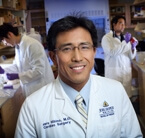
Narutoshi Hibino, M.D., Ph.D.
Pediatric cardiac surgeon and biomedical engineer Narutoshi Hibino began his study of tissue engineering in Japan and continued his research in the United States when he arrived at Yale a decade ago. After completing fellowships at the Children’s National Medical Center in Washington, D.C., and Nationwide Children’s Hospital in Ohio, he joined the faculty at Johns Hopkins Children’s Center. There we sat down with him for a brief update on his current activities.
How do you approach these very complex patients with congenital heart disease?
It depends on the child’s state of mind. Sometimes you work with a patient who has had heart defects since birth and have no trouble accepting their condition. If you have a patient who recently developed complications, they can harbor confusion because they were healthy before. As a surgeon, I don’t always get to interact with my patients but I find it’s best to tackle each case individually because while some share similarities, they are also rather unique in some ways. No two kids are alike.
Tell us about your current research.
I began my research studying the cells’ role in generating cardiac tissue, but over time my team and I found that we don’t need to grow cells when implanting artificial devices such as vessels into the heart because cardiac cells will grow over these new structures. It’s incredible. Currently
we’re focusing on 3-D printing to design and implant artificial vessels into the hearts of patients with congenital heart disease.
How did you get interested in 3-D printing?
3-D printing, which has become popular in medicine lately, gives the surgeon the opportunity to make a model of the patient’s heart, and print and implant the new structure in a way that works with the patient’s unique anatomy. Surgeons face a real challenge when tailoring unique
structures, such as vessels, under the pressure and time constraints of surgery. Our hope is that 3-D printing can help solve those problems.
Does the heart accept that new structure?
Yes, though we are constantly trying to improve printing materials. The plastic in 3-D printing is too hard, not pliable enough. Other materials have proven to have their own limits. We continue to look for the ideal fit.
What’s next?
We are trying to bring our vision for medicine closer to the reality of medicine. I hope that in the future we can start generating cardiac tissue, which is far more difficult than 3-D printing. My goal is to improve outcomes and quality of life for my patients, and that’s what fuels and inspires the work that I do in my lab day in and day out.
